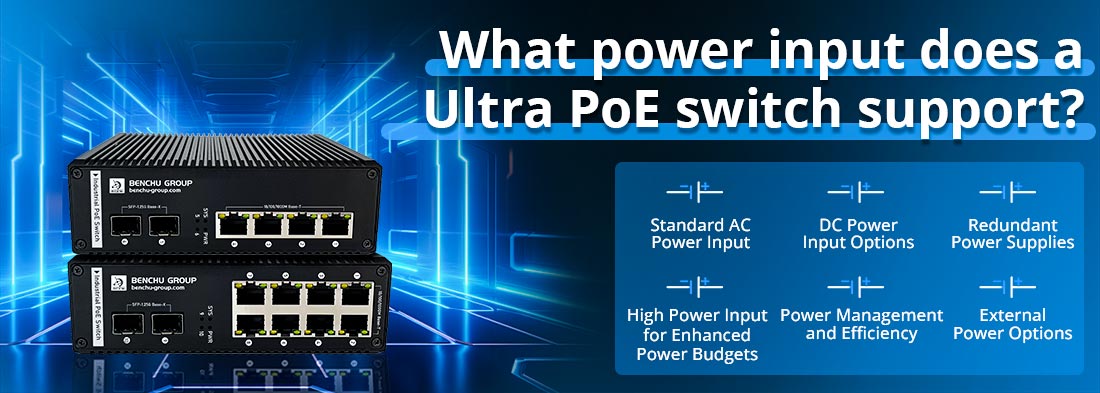
يمكن أن يختلف مدخل الطاقة لمحول Ultra PoE وفقًا لطراز المحول وتصميمه. ومع ذلك، تم تصميم محولات Ultra PoE للتعامل مع متطلبات الطاقة الأعلى من محولات PoE القياسية، مما يؤثر على نوع مدخلات الطاقة التي تتطلبها. فيما يلي تفصيل تفصيلي لخيارات إدخال الطاقة التي تدعمها هذه المفاتيح عادةً:
1. مدخلات طاقة التيار المتردد القياسية
--- معظم الترا مفاتيح بو تم تصميمها لسحب الطاقة من مصدر طاقة قياسي (التيار المتردد)، يتراوح عادة بين 100-240 فولت تيار متردد. إن نطاق الإدخال الواسع هذا يجعلها مناسبة للاستخدام في مختلف المناطق والبنى التحتية للطاقة دون الحاجة إلى محولات الجهد الكهربي.
--- تقوم وحدة إمداد الطاقة الداخلية (PSU) الخاصة بالمحول بتحويل إدخال التيار المتردد هذا إلى طاقة التيار المستمر (التيار المباشر) اللازمة المستخدمة لتشغيل المحول وتوصيل PoE إلى الأجهزة المتصلة.
2. خيارات إدخال طاقة التيار المستمر
--- قد تدعم بعض محولات Ultra PoE ذات السعة العالية أو الصناعية إدخال طاقة التيار المباشر المباشر. وهذا مفيد بشكل خاص في المنشآت التي تكون فيها طاقة التيار المستمر مفضلة أو مطلوبة، كما هو الحال في تطبيقات الصناعة أو النقل أو الطاقة المتجددة (مثل أنظمة الطاقة الشمسية).
--- يمكن أن تختلف نطاقات إدخال التيار المستمر النموذجية بشكل كبير، مثل 48 فولت تيار مستمر أو 54 فولت تيار مستمر، اعتمادًا على احتياجات الطاقة للمحول ومعايير PoE التي يدعمها. غالبًا ما تتطلب محولات Ultra PoE جهدًا كهربيًا أعلى لتوفير خرج طاقة متزايد للأجهزة المتصلة.
3. إمدادات الطاقة الزائدة
--- لضمان الموثوقية، تأتي العديد من محولات Ultra PoE الخاصة بالمؤسسات والصناعات مجهزة بمصادر إمداد طاقة مزدوجة أو زائدة عن الحاجة. تسمح هذه الأنظمة الزائدة للمفتاح بمواصلة التشغيل حتى في حالة فشل مصدر طاقة واحد، مما يوفر توصيلًا مستمرًا للطاقة. قد تدعم المستلزمات الزائدة التيار المتردد، أو التيار المباشر، أو مزيجًا من الاثنين معًا.
--- تعتبر مدخلات الطاقة الزائدة ضرورية بشكل خاص في البيئات عالية التوفر مثل مراكز البيانات أو البنية التحتية الحيوية أو أنظمة المراقبة.
4. مدخلات طاقة عالية لميزانيات الطاقة المحسنة
تتمتع محولات Ultra PoE عمومًا بميزانيات طاقة إجمالية أعلى لدعم الأجهزة التي تتطلب أكثر من مستويات الطاقة النموذجية PoE أو PoE+ أو PoE++. يرتبط تصنيف مدخلات الطاقة للمفتاح بقدرات الإخراج الخاصة به. على سبيل المثال:
--- التبديل الذي يدعم بو++ (IEEE 802.3bt Type 4)، والذي يمكنه توفير ما يصل إلى 100 واط لكل منفذ، قد يتطلب وحدة PSU أكثر قوة قادرة على توفير قدر كبير من القوة الكهربائية لضمان قدرة جميع المنافذ على توفير أقصى قدر من الإخراج في وقت واحد.
--- بالنسبة للمحولات القادرة على توفير طاقة تتجاوز 100 واط لكل منفذ، قد يتم تصميم مصادر طاقة الإدخال للتعامل مع وحدات كهربائية أعلى، مثل 500 واط، أو 750 واط، أو أكثر، اعتمادًا على العدد الإجمالي لمنافذ PoE والحد الأقصى لإخراجها.
5. إدارة الطاقة والكفاءة
غالبًا ما يتم تصميم محولات Ultra PoE باستخدام أنظمة إدارة الطاقة الفعالة التي تنظم الطاقة وتخصيصها وفقًا لاحتياجات الأجهزة المتصلة. يمكن لمصدر الطاقة الداخلي ضبط توزيع الطاقة ديناميكيًا وقد يتضمن ميزات مثل:
--- قدرات Ultraing للطاقة، والتي تعمل على تضخيم مخرجات التيار المستمر لضمان توصيل الطاقة العالية إلى الأجهزة.
--- تحديد أولويات الطاقة، الذي يخصص الطاقة بشكل تفضيلي للمنافذ المهمة عندما يقترب إجمالي الطلب على الطاقة من حد إمداد المدخلات.
6. خيارات الطاقة الخارجية
في بعض الحالات المتخصصة، قد يتم تصميم محولات Ultra PoE لاستخدام وحدات طاقة خارجية لمزيد من المرونة. يمكن أن يشمل ذلك القدرة على الاتصال بـ:
--- أنظمة النسخ الاحتياطي للبطاريات، لتوفير الطاقة غير المنقطعة (UPS) في الأنظمة الحيوية.
--- مصادر الطاقة الشمسية أو المتجددة، وخاصة في المواقع النائية أو خارج الشبكة حيث لا تتوفر مصادر الطاقة التقليدية.
نظرة عامة على متطلبات طاقة الإدخال
| ميزة | الترا بو التبديل |
| مدخلات التيار المتردد القياسية | 100-240 فولت تيار متردد، 50/60 هرتز |
| مدخلات الطاقة العاصمة | عادة 48 فولت تيار مستمر إلى 54 فولت تيار مستمر (يختلف حسب الموديل) |
| إمدادات الطاقة الزائدة | نعم، غالبًا ما يتم دعمه للتوفر العالي |
| ميزانية الطاقة | وحدة PSU ذات قوة كهربائية عالية (على سبيل المثال، 500 واط، 750 واط، أو أكثر) |
| خيارات الطاقة الخارجية | قد يدعم البطارية أو UPS أو مدخلات الطاقة الشمسية |
اعتبارات اختيار طاقة الإدخال لمحول Ultra PoE
1. متطلبات طاقة الجهاز: تأكد من أن طاقة الإدخال يمكن أن تدعم الحد الأقصى لميزانية الطاقة اللازمة لجميع أجهزة PoE المتصلة.
2. بيئة التثبيت: اختر إدخال التيار المتردد أو التيار المباشر بناءً على الموقع والبنية التحتية للطاقة. قد تستفيد المناطق الصناعية أو النائية من خيارات المدخلات DC أو المتجددة.
3. احتياجات الموثوقية: بالنسبة للعمليات الحرجة، فكر في استخدام مفاتيح ذات مدخلات طاقة مزدوجة أو زائدة عن الحاجة للحفاظ على الطاقة في حالة الفشل.
4. ميزانية الطاقة الإجمالية: تأكد من أن مدخلات الطاقة تتوافق مع ميزانية الطاقة الإجمالية للمفتاح للحصول على الحد الأقصى من الإخراج المتزامن عبر جميع المنافذ.
خاتمة
الترا مفاتيح بو تم تصميمها للتعامل مع مدخلات الطاقة العالية، وعادةً ما تدعم مصادر طاقة التيار المتردد القياسية وغالبًا ما تقدم خيارات إدخال التيار المستمر للتطبيقات المتخصصة أو الصناعية. وقد تأتي مزودة بمصادر طاقة زائدة عن الحاجة لمزيد من الموثوقية ويمكن أن تتضمن خيارات طاقة خارجية لسيناريوهات النشر الفريدة. تضمن هذه القدرات أن محولات Ultra PoE يمكنها توفير مخرجات طاقة أعلى ونطاق ممتد وتشغيل موثوق في البيئات الصعبة.